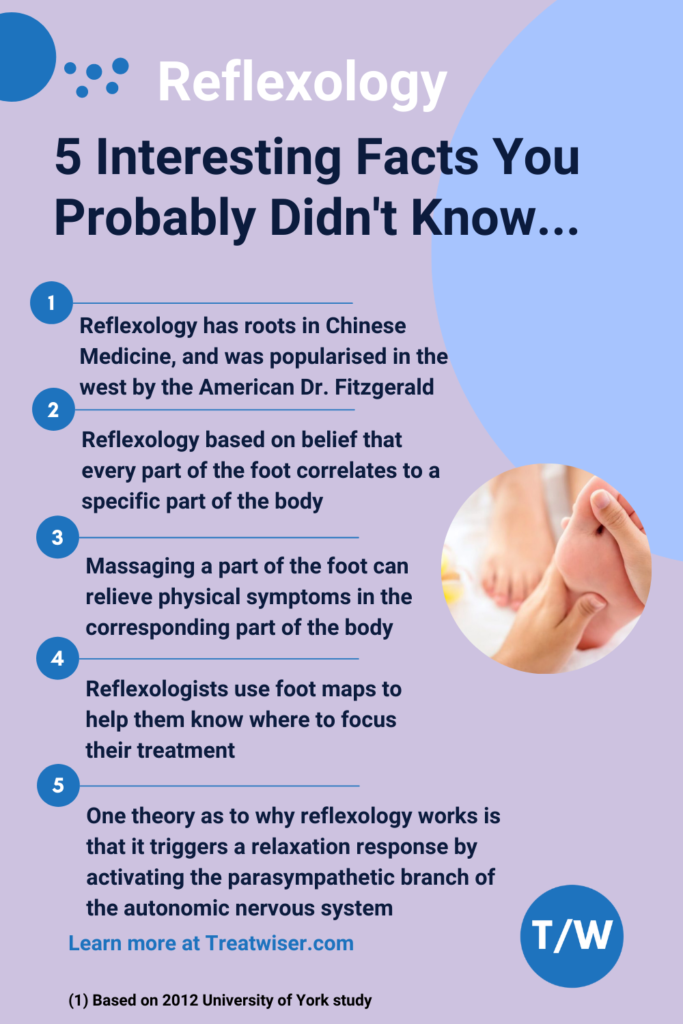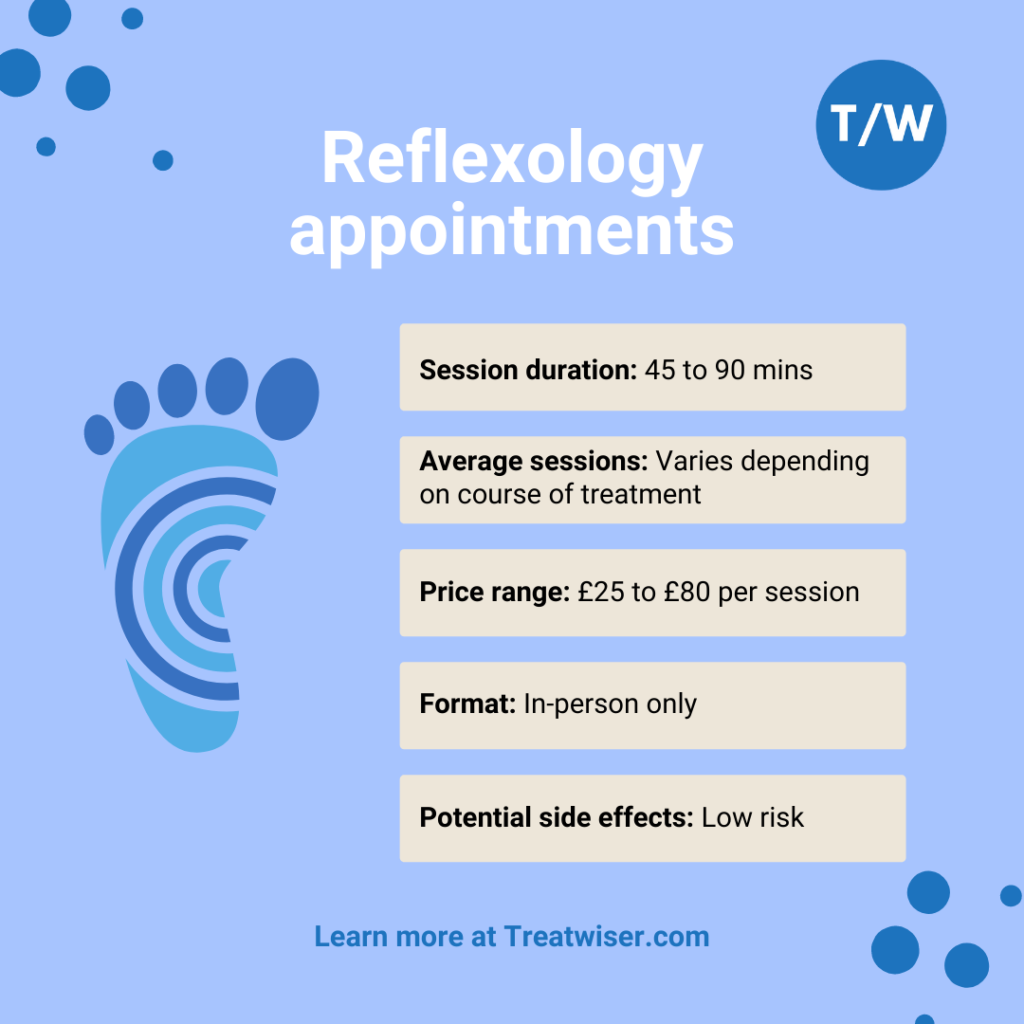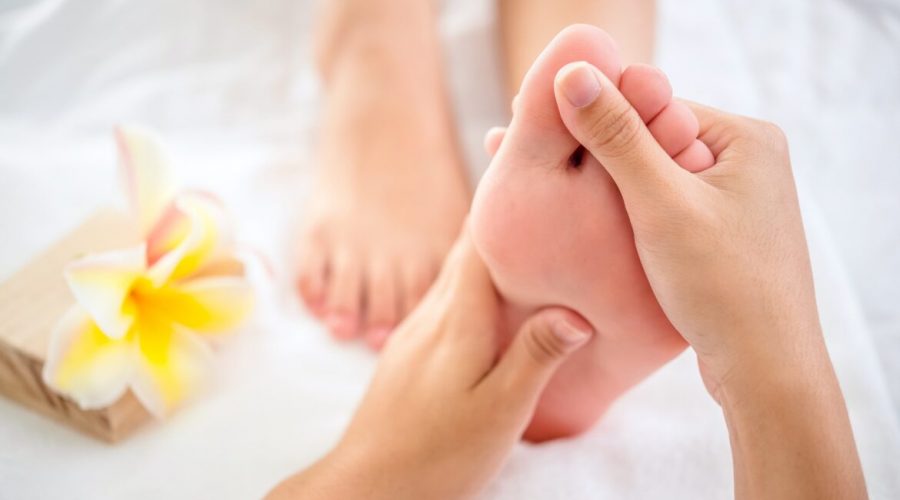If you are looking for a natural way to improve your overall wellbeing, aid relaxation and move your body into a healing state, a form of touch therapy called reflexology treatment may help.
Reflexology is based on the theory that your hands and feet are connected to the rest of your body including the organs and systems. It is a form of therapy that has been growing in popularity.
In this article, we explore the origins and theory behind this 5,000-year-old complementary therapy as well as how does reflexology work, what to expect, so you can decide if it is right for you.
Table of contents
- 5 interesting facts about reflexology
- What is reflexology?
- What is the theory behind reflexology?
- When and how is reflexology used?
- What is the evidence to support reflexology?
- What can I expect as an reflexology patient?
5 interesting facts about reflexology

What is reflexology treatment?
Reflexology is a form of massage therapy focused primarily on the feet but can also be done on the hands and face as well.
Reflexology is a safe and non-invasive therapy which involves specific thumb, finger, and hand massaging techniques. The theory behind it is that the feet are a micro-system of the body and applying pressure to a specific pressure point on the feet can influence corresponding part of the body. In doing so, feet reflexology is believed to relieve tension, support the body’s healing capacity and stimulate the release of endorphins in the brain.
Reflexology aims to restore balance to the body
In a world filled with stress and hectic lifestyles, this gentle therapy aims to improve overall well-being by encouraging relaxation and bringing balance to the body. Practitioners of reflexology believe in supporting patients holistically to enhance the body’s natural healing mechanisms.
The history of reflexology treatment in the west stems from a European system called zone therapy
Reflexology is an ancient healing art with roots in Traditional Chinese Medicine, but it was popularised in the west by the American doctor William Fitzgerald.
Dr Fitzgerald developed “zone therapy” in the early 20th century, based on the theory that he could promote healing by stimulating “zones” on the hands and feet that corresponded with different parts of the body.
In the 1930s a physiotherapist named Eunice Ingham built on this work by extensively mapping reflex points on the feet with corresponding glands, organs, and body systems. This became the Western reflexology that we know today.
What is the theory behind reflexology treatment?
Reflexology is one of the most popular complementary therapies in the UK. But how exactly does it work?
Reflexologists believe that the feet are a micro-system of the body and so every part of the foot correlates to a specific part of the body. This means that massaging a part of the foot can relieve physical symptoms in the corresponding part of the body including tissues, glands, organs, and systems.
Reflexology maps of feet and reflexology hands charts act as guides to therapists / practitioners to help them know where to focus their treatment depending on what the clients presenting conditions are.
There are several theories as to how reflexology works but we still do not know the exact mechanism (and may never). There is a chance it is a combination of all of them.
Nerve impulse – this theory believes that treatment works predominantly through the nervous system. There are approximately 7,000 nerve endings in each foot so working a part of the foot sends a message to the brain via the central nervous system and then back to the corresponding part of the body.
Relaxation effect – this theory believes that reflexology triggers a relaxation response by activating the parasympathetic branch of the autonomic nervous system (also known as the ‘rest and digest’ system). This may reduce the level of pain, discomfort and illness caused by stress.
Life energy and meridians – this theory is closely tied to Traditional Chinese Medicine and Acupuncture therapies which believe that stagnated energy or poor circulation cause illness and disease. As six of the meridians, or energy channels, begin or end in the feet, reflexology is a very effective therapy for improving circulation (1).
Placebo effect – this may play a role as it does with other therapies.
When and how is reflexology therapy applied?
Anyone and everyone from babies through to pensioners may benefit from reflexology. Patients tend to split into 3 categories:
1) Those who come with a specific complaint or reason (see list below)
2) Those who use it as a maintenance or preventative treatment to mitigate the effects of stress.
3) Those who just find it wonderfully relaxing and do it as a treat
Reflexologists are not allowed to diagnose and cannot claim to cure any medical conditions; however, people commonly seek out reflexology for the following reasons:
- Anxiety
- Headaches
- Chronic pain (including muscular/skeletal pain)
- Improve circulation
- Improve immunity
- Low energy
- Digestive problems
- Allergies
- Insomnia
- Premenstrual syndrome
- Blood pressure
- Stress related conditions
- Hormonal imbalances especially related to the menstrual cycle
- Foot pain and other foot related problems (including plantar fascitis, bunions, achilles pain, etc.,)
- Help during pregnancy
What is the evidence to support reflexology treatment?
There is plenty of anecdotal evidence but no robust clinical evidence to support the healing benefits of feet reflexology
However, there have been several small studies that suggest reflexology may be a safe therapy for enhancing relaxation and promoting general well-being.
Stress and Anxiety: Research supports the use of reflexology as an adjunct therapy for reducing anxiety levels, particularly for those going through cancer treatment (2).
Sleep: Reflexology may promote restful sleep. A 2017 study published in Complementary Therapies in Clinical Practice found reflexology sessions influenced brain wave activity and promoted N1 and N2 NREM sleep phases (3).
Pain: Regular reflexology has been shown to help those with tension headaches and chronic backache (4, 5). It may promote pain relief by encouraging relaxation, reducing muscle tension, and stimulating the release of “feel-good” endorphins,
Allergies and Sinusitis: A study on adults with chronic sinusitis compared the effects of daily nasal irrigation to reflexology treatment. Promisingly, both treatments improved symptoms in 70% of participants and resulted in reduced use of sinus medication (6).
Premenstrual Syndrome (PMS): A 2019 meta-analysis found that 6-10 reflexology sessions of roughly 40 minutes may be an effective treatment for reducing the severity of PMS symptoms (7).
What can I expect as a reflexologist patient?
The reflexology appointment
At your first appointment, a trained reflexologist will take a health and lifestyle history and discuss your concerns/presenting conditions. The initial appointment may last up to 90 minutes, but thereafter sessions typically last 45-60 minutes.
Reflexology is a completely non-invasive therapy and only requires that you take your shoes and socks off and relax comfortably on a chair or a massage table.
Your therapist / practitioner will apply some lubrication to your feet (oil, cream, balm), do some gentle warm up sequences and then start the treatment. Whilst they work the whole foot, they are looking for areas of sensitivity and feeling for areas where there are differences in texture in the tissue which may indicate possible imbalances in the body. They then thoroughly work these areas through. Despite the fact that some areas may be a little bit uncomfortable it is a very relaxing treatment, and most people feel an immediate sense of calm – it’s also common to fall asleep!
At the end of the session, you will be encouraged to drink plenty of water and take it easy for the rest of the day. This helps your body remain in a healing state and minimize any healing crisis you might have.

How do I find a reflexologist near me and what qualifications should they have?
To get the most out of reflexology, you require a well-trained therapist / practitioner. Unfortunately, this therapy is unregulated in the UK and, legally, there are no minimum training requirements.
To ensure the therapist / practitioner has suitable qualifications and abides by a code of ethics, we recommend finding a reflexologist who is registered with one of the following voluntary professional regulators:
- Association of Reflexologists
- Professional Reflexology
- British Reflexology Association
- Complementary and Natural Healthcare Council
You can also use Treatwiser’s directory to find a reflexologist near me. Use the search features to narrow your search by location, professional body membership status, and more.
Be wary of hotels. Just because a treatment is expensive or takes place at an impressive venue, does not mean it is good for you! Sometimes these practitoners / therapists are trained in a wide variety of treatments and lack deep expertise.
Be wary of salons / hairdressers – Check qualifications. There are some courses out there that enable you to practice after just a weekends training
How much will it cost?
As is the case with many holistic therapies, Reflexology is not available on the NHS and most people will need to pay for it privately. Prices may vary but generally range from £25 to £80 per session.
How many appointments will I need and over what period?
The number of treatments required very much depends on why you are seeing a reflexologist.
If it is a preventative treatment, then some patients come once a month on average, with others coming once a week. Visit frequency varies depending on stress levels and cost.
If someone presents with a specific health complaint, then they might need to come twice a week for 2-3 weeks. Visit frequency can be key, as the effect of the treatment can wear off and put you back to square one.
What are the risks associated with reflexology treatment?
Reflexology is a very low-risk treatment however, you should avoid reflexology if you have:
- Foot ulcers
- A foot or ankle wound or injury
- A bruising condition
- Blood clots/DVT
Additionally, if you are pregnant or have a chronic health condition, please consult your healthcare practitioner before embarking on your reflexology journey.
What do patients and therapists say about reflexology
Read some testimonials to hear what patients and therapists are saying about their reflexology experiences:
Resources and further reflexology treatment information
- https://journals.sagepub.com/doi/10.1258/phleb.2012.012b01
- https://pubmed.ncbi.nlm.nih.gov/10660924/
- https://pubmed.ncbi.nlm.nih.gov/28779938/
- https://pubmed.ncbi.nlm.nih.gov/10234869/
- https://www.ncbi.nlm.nih.gov/pmc/articles/PMC5114793/
- https://pubmed.ncbi.nlm.nih.gov/11458213/
- https://bpsmedicine.biomedcentral.com/articles/10.1186/s13030-019-0165-0
DISCLAIMER: The Site cannot and does not contain medical / health advice. The medical / health information is provided for general informational and educational purposes only and is not a substitute for professional advice. Accordingly, before seeking any form of medical advice, diagnoses or treatment based upon such information, we encourage you to consult with your GP or other qualified health practitioner. You must never disregard professional medical advice or delay in seeking it because of something mentioned on this Site. The use or reliance of any information contained on the site is solely at your own risk.




